Variable Water Flow Control of Hybrid Geothermal Heat Pump System
Abstract
:1. Introduction
2. Hybrid GHP System
3. Variable Water Flow Control of Hybrid GHP System
3.1. Constant Water Flow Control
3.2. Variable Water Flow Control
3.3. Relevant Study
4. Prediction of COP for Water Flow Control
5. Future Research of Hybrid GHP
- (1)
- It is possible to design a hybrid system that combines the GHP system with existing heat sources and other new heat sources. Research can be conducted on theoretical analysis and performance evaluation according to hybrid system combinations.
- (2)
- The hybrid GHP system and the interlocking control plan of the HVAC system can contribute to indoor comfort and energy saving.
- (3)
- Prediction models of monitoring and control parameters can be materialized for improved control technology of HGHP systems. In addition, predictive model optimization, predictive-model-based control technology, and FDD technology can be developed according to the model development method.
- (4)
- HGHP research was mainly conducted through theoretical analysis and simulation. Field applications, experiments, and verification studies can be conducted for the advancement of technology.
6. Conclusions
- (1)
- The heat accumulation phenomenon caused by an imbalance of heating and cooling loads in a building confirmed that the heat source temperature increases as the operating age of the GHP system increases. As a result, the performance degradation of the GHP system and the need for a hybrid GHP system to improve it were identified. The characteristics of the hybrid GHP system and existing research trends were analyzed. In the study of the design and application of hybrid GHP systems, the focus has been on the analysis of the heating and cooling performance under different heating and cooling heat source systems and the configuration of the GHP system. Compared to the many studies on the design and cooling and heating performance analysis of hybrid GHP systems, there is a lack of research on the development of operating conditions and measures to improve the performance of hybrid GHP systems. For efficient operation of the hybrid GHP system, it is necessary to analyze the COPs during system operation. However, previous studies only analyzed the performance of the developed operation method and did not confirm the COPs during operation, so the economic analysis of the operation method is lacking.
- (2)
- An analysis of the theoretical and existing research on flow control in hybrid GHP systems shows that in hybrid GHP systems, the circulating pump has been subjected to constant flow control, which provides a constant flow rate of design maximum load. Pump energy, total energy comparison, and heating and cooling performance of geothermal heat pump systems based on conventional constant flow control and VRF control have been analyzed, but performance analysis based on flow control is lacking. Existing studies have analyzed the frequency of the compressor and derived the differential pressure setpoint or temperature setpoint for flow control to save energy. Flow rate control may cause energy waste and decrease the overall system COP in partial load situations. This is because the hybrid GHP system is used mainly as a heating and cooling heat source system for part of the building load rather than the entire load. Hence, the need for flow rate control in the hybrid GHP system is confirmed.
- (3)
- This study investigated the theory and existing research trends on machine learning-based COP prediction models that can predict COPs with a small number of monitoring sensors. Existing studies on predicting COPs of GHP systems have developed prediction models by selecting input values based on mathematical models, collecting data through multiple measurement points, and utilizing data from the production environment. However, the application of such models may be limited by the field environment, and it is confirmed that it is necessary to predict the COP using machine learning based on existing field monitoring data. Through previous research, we confirmed the feasibility of developing a COP prediction model for hybrid GHP systems based on machine learning. It is necessary to develop a COP prediction model that shows high precision at low cost by utilizing input data that are commonly observed during the operation of GHP systems and are easy to measure.
Author Contributions
Funding
Institutional Review Board Statement
Informed Consent Statement
Data Availability Statement
Conflicts of Interest
References
- Satola, D.; Wiberg, A.H.; Singh, M.; Babu, S.; James, B.; Dixit, M.; Sharston, R.; Grynberg, Y.; Gustavsen, A. Comparative review of international approaches to net-zero buildings: Knowledge-sharing initiative to develop design strategies for greenhouse gas emissions reduction. Energy Sustain. Dev. 2022, 71, 291–306. [Google Scholar] [CrossRef]
- United Nations Environment Programme. 2020 Global Status Report for Buildings and Construction: Towards a Zero-Emission, Efficient and Resilient Buildings and Construction Sector; United Nations Environment Programme: Nairobi, Kenya, 2020. [Google Scholar]
- International Energy Agency. Korea 2020 Energy Policy Review; International Energy Agency: Paris, France, 2020. [Google Scholar]
- Kim, P.; Cho, S.-B.; Yim, M.-S. Examination of excess electricity generation patterns in South Korea under the renewable initiative for 2030. Nucl. Eng. Technol. 2022, 54, 2883–2897. [Google Scholar] [CrossRef]
- Sharmin, T.; Khan, N.R.; Akram, S.; Ehsan, M.M. A State-of-the-Art Review on Geothermal Energy Extraction, Utilization, and Improvement Strategies: Conventional, Hybridized, and Enhanced Geothermal Systems. Int. J. Thermofluids 2023, 18, 100323. [Google Scholar] [CrossRef]
- Li, H.X.; Okolo, D.E.; Tabadkani, A.; Arnel, T.; Zheng, D.; Shi, L. An integrated framework of ground source heat pump utilisation for high-performance buildings. Sci. Rep. 2023, 13, 371. [Google Scholar] [CrossRef]
- Kim, J.Y.; Kim, H.J. An Analysis on the Improvement Effect of Environmental Benefit from the Promotion of Geothermal Air-Conditioning and Heating System in Korea; Korea Energy Economics Institute: Ulsan, Republic of Korea, 2020. [Google Scholar]
- Molavi, J.; McDaniel, J. A Review of the Benefits of Geothermal Heat Pump Systems in Retail Buildings. Procedia Eng. 2016, 145, 1135–1143. [Google Scholar] [CrossRef]
- Yu, S.-W.; Jung, Y.-J.; Kim, S.-H.; Jo, J.-H.; Kim, Y.-S.; Cho, Y.-H. A study on the optimized control strategies of geothermal heat pump system and absorption chiller-heater. Int. J. Energy Res. 2013, 38, 1083–1098. [Google Scholar] [CrossRef]
- Seo, Y.; Seo, U.-J. Ground source heat pump (GSHP) systems for horticulture greenhouses adjacent to highway interchanges: A case study in South Korea. Renew. Sustain. Energy Rev. 2021, 135, 110194. [Google Scholar] [CrossRef]
- Cho, H.U.; Nam, Y.; Choi, E.J.; Choi, Y.J.; Kim, H.; Bae, S.; Moon, J.W. Comparative analysis of the optimized ANN, SVM, and tree ensemble models using Bayesian optimization for predicting GSHP COP. J. Build. Eng. 2021, 44, 103411. [Google Scholar] [CrossRef]
- Khammayom, N.; Maruyama, N.; Chaichana, C. Simplified model of cooling/heating load prediction for various air-conditioned room types. Energy Rep. 2020, 6 (Suppl. 2), 344–351. [Google Scholar] [CrossRef]
- Choi, W.; Ooka, R.; Nam, Y. Impact of long-term operation of ground-source heat pump on subsurface thermal state in urban areas. Sustain. Cities Soc. 2018, 38, 429–439. [Google Scholar] [CrossRef]
- Kavanaugh, S. A Design Method for Hybrid Ground-Source Heat Pump. ASHRAE Trans. 1998, 104, 691. [Google Scholar]
- Kim, Y.-J.; Yang, L.; Entchev, E.; Cho, S.; Kang, E.-C.; Lee, E.-J. Hybrid Solar Geothermal Heat Pump System Model Demonstration Study. Front. Energy Res. 2022, 9, 778501. [Google Scholar] [CrossRef]
- Liu, Z.; Yang, X.; Ali, H.M.; Liu, R.; Yan, J. Multi-objective optimizations and multi-criteria assessments for a nanofluid-aided geothermal PV hybrid system. Energy Rep. 2023, 9, 96–113. [Google Scholar] [CrossRef]
- Hackel, S.; Perzborn, A. Hybrid Hround-Source Heat Pump Installations: Experiences, Improvements and Tools; Energy Center of Wisconsin: Madison, WI, USA, 2011. [Google Scholar]
- Dusseault, B.; Pasquier, P. Usage of the net present value-at-risk to design ground-coupled heat pump systems under uncertain scenarios. Renew. Energy 2021, 173, 953–971. [Google Scholar] [CrossRef]
- U.S. Department of Energy. Assessment of Hybrid Geothermal Heat Pump Systems; U.S. Department of Energy: Washington, DC, USA, 2001. [Google Scholar]
- Liu, Z.; Li, Y.; Xu, W.; Yin, H.; Gao, J.; Jin, G.; Lun, L.; Jin, G. Performance and feasibility study of hybrid ground source heat pump system assisted with cooling tower for one office building based on one Shanghai case. Energy 2019, 173, 28–37. [Google Scholar] [CrossRef]
- Qi, Z.; Gao, Q.; Liu, Y.; Yan, Y.; Spitler, J.D. Status and development of hybrid energy systems from hybrid ground source heat pump in China and other countries. Renew. Sustain. Energy Rev. 2014, 29, 37–51. [Google Scholar] [CrossRef]
- Shin, J.-H.; Cho, Y.-H. Development of a Variable Water Flow Rate Control Method for the Circulation Pump in a Geothermal Heat Pump System. Energies 2018, 11, 718. [Google Scholar] [CrossRef]
- Hou, G.; Taherian, H. Performance analysis of a hybrid ground source heat pump system integrated with liquid dry cooler. Appl. Therm. Eng. 2019, 159, 113830. [Google Scholar] [CrossRef]
- Shin, J.-H.; Kim, Y.-I.; Cho, Y.-H. Development of Operating Method of Multi-Geothermal Heat Pump Systems Using Variable Water Flow Rate Control and a COP Prediction Model Based on ANN. Energies 2019, 12, 3894. [Google Scholar] [CrossRef]
- Shin, J.-H.; Cho, Y.-H. Machine-Learning-Based Coefficient of Performance Prediction Model for Heat Pump Systems. Appl. Sci. 2021, 12, 362. [Google Scholar] [CrossRef]
- Tien, P.W.; Wei, S.; Darkwa, J.; Wood, C.; Calautit, J.K. Machine Learning and Deep Learning Methods for Enhancing Building Energy Efficiency and Indoor Environmental Quality—A Review. Energy AI 2022, 10, 100198. [Google Scholar] [CrossRef]
- Kim, H.-J.; Cho, Y.-H. Optimization of supply air flow and temperature for VAV terminal unit by artificial neural network. Case Stud. Therm. Eng. 2022, 40, 102511. [Google Scholar] [CrossRef]
- Kim, H.-J.; Cho, Y.-H.; Lee, S.-H. A study on the sensor calibration method using data-driven prediction in VAV terminal unit. Energy Build. 2021, 258, 111449. [Google Scholar] [CrossRef]
- Kavanaugh, S.; Rafferty, K. Geothermal Heating and Cooling: Design of Ground-Source Heat Pump Systems; ASHRAE: Atlanta, GA, USA, 2014. [Google Scholar]
- Wang, F.; You, T. Comparative analysis on the life cycle climate performance of ground source heat pump using alternative refrigerants. Case Stud. Therm. Eng. 2023, 42, 10276. [Google Scholar] [CrossRef]
- You, T.; Li, X.; Cao, S.; Yang, H. Soil thermal imbalance of ground source heat pump systems with spiral-coil energy pile groups under seepage conditions and various influential factors. Energy Convers. Manag. 2018, 178, 123–136. [Google Scholar] [CrossRef]
- Gao, W.; Masum, S.; Qadrdan, M.; Thomas, H.R. A numerical study on performance efficiency of a low-temperature horizontal ground-source heat pump system. Energy Build. 2023, 291, 15. [Google Scholar] [CrossRef]
- Shin, J.-H. A Variable Water Flow Rate Control Method based on COP Prediction Model of Hybrid Geothermal Heat Pump System. Ph.D. Thesis, Yeungnam University, Gyeongsan, Republic of Korea, 2022. [Google Scholar]
- Lazzarin, R.; Noro, M. Photovoltaic/Thermal (PV/T)/ground dual source heat pump: Optimum energy and economic sizing based on performance analysis. Energy Build. 2020, 211, 109800. [Google Scholar] [CrossRef]
- Weeratunge, H.; Aditya, G.R.; Dunstall, S.; de Hoog, J.; Narsilio, G.; Halgamuge, S. Feasibility and performance analysis of hybrid ground source heat pump systems in fourteen cities. Energy 2021, 234, 121254. [Google Scholar] [CrossRef]
- Wang, J.; Gao, X.; Yin, Z.; Li, F. Study of Operating Control Strategies for Hybrid Ground Source Heat Pump System with Supplemental Cooling Tower. In Proceedings of the 2009 IITA International Conference on Services Science, Management and Engineering, Zhangjiajie, China, 11–12 July 2009; pp. 507–510. [Google Scholar] [CrossRef]
- Albert, R.B. Hybrid Geothermal for Hotel. ASHARE J. 2008, 50, 48. [Google Scholar]
- Hackel, S.; Nellis, G.; Klein, S. Optimization of hybrid geothermal heat pump systems. In Proceedings of the 9th International IEA Heat Pump Conference, Zurich, Switzerland, 20–22 May 2008. [Google Scholar]
- Hackel, S.; Pertzborn, A. Effective design and operation of hybrid ground-source heat pumps: Three case studies. Energy Build. 2011, 43, 3497–3504. [Google Scholar] [CrossRef]
- Wang, E.; Fung, A.S.; Qi, C.; Leong, W.H. Performance prediction of a hybrid solar ground-source heat pump system. Energy Build. 2012, 47, 600–611. [Google Scholar] [CrossRef]
- Zhang, Q.; Lv, N.; Chen, S.; Shi, H.; Chen, Z. Study on Operating and Control Strategies for Hybrid Ground Source Heat Pump System. Procedia Eng. 2015, 121, 1894–1901. [Google Scholar] [CrossRef]
- Xu, X. Simulation of Hybrid Ground Source Heat Pump Systems and Experimental Validation. Eng. Env.-Ment. Sci. 2006, 111313619. Available online: https://www.semanticscholar.org/paper/Simulation-of-Hybrid-Ground-Source-Heat-Pump-and-Xu/425f31fd2adcdcffec9b0f20b7502d47361dc749 (accessed on 30 May 2023).
- Gao, Q.; Li, M.; Yu, M.; Spitler, J.D.; Yan, Y.Y. Review of development from GSHP to UTES in China and other countries. Renew. Sustain. Energy Rev. 2009, 13, 1383–1394. [Google Scholar] [CrossRef]
- You, T.; Wu, W.; Yang, H.; Liu, J.; Li, X. Hybrid photovoltaic/thermal and ground source heat pump: Review and perspective. Renew. Sustain. Energy Rev. 2021, 151, 111569. [Google Scholar] [CrossRef]
- Salmasi, F.; Abraham, J.; Salmasi, A. Evaluation of variable speed pumps in pressurized water distribution systems. Appl. Water Sci. 2022, 12, 51. [Google Scholar] [CrossRef]
- Montagud, C.; Corberán, J.; Montero, A. In situ optimization methodology for the water circulation pumps frequency of ground source heat pump systems. Energy Build. 2014, 68, 42–53. [Google Scholar] [CrossRef]
- Kim, S.H. The Effect of Control Strategies on Energy Saving for Variable Speed Pump in Building. M.S. Thesis, Hannam University, Daejeon, Republic of Korea, 2012. [Google Scholar]
- Song, L.; Joo, I.; Wang, G. Uncertainty analysis of a virtual water flow measurement in building energy consumption monitoring. HVACR Res. 2012, 18, 997–1010. [Google Scholar]
- Zhenjun, M.; Shengwei, W. Energy efficient control of variable speed pumps in complex building central air-conditioning systems. Energy Build. 2009, 41, 197–205. [Google Scholar]
- Lu, L.; Cai, W.; Xie, L.; Li, S.; Soh, Y.C. HVAC system optimization-in building section. Energy Build. 2005, 37, 11–12. [Google Scholar] [CrossRef]
- Puttige, A.R.; Andersson, S.; Östin, R.; Olofsson, T. Modeling and optimization of hybrid ground source heat pump with district heating and cooling. Energy Build. 2022, 264, 112065. [Google Scholar] [CrossRef]
- Xia, L.; Ma, Z.; McLauchlan, C.; Wang, S. Experimental investigation and control optimization of a ground source heat pump system. Appl. Therm. Eng. 2017, 127, 70–80. [Google Scholar] [CrossRef]
- Miglani, S.; Orehounig, K.; Carmeliet, J. Design and optimization of a hybrid solar ground source heat pump with seasonal regeneration. Energy Procedia 2017, 122, 1015–1020. [Google Scholar] [CrossRef]
- Zhao, D.; Cui, P.; Gao, Y.; Zhang, W.; An, H. Research on the simulation and operation control strategy of hybrid ground source heat pump system. Procedia Eng. 2017, 205, 1507–1514. [Google Scholar] [CrossRef]
- Shin, J.; Lee, J.; Cho, Y. A COP Prediction Model of Hybrid Geothermal Heat Pump Systems based on ANN and SVM with Hyper-Parameters Optimization. Appl. Sci. 2023, 13, 7771. [Google Scholar] [CrossRef]
- Shin, J.-H.; Seong, Y.-B.; Kim, Y.-I.; Cho, Y.-H. Development of Changeover Operating Method Based on Performance Prediction of Hybrid Geothermal Heat Pump Systems through Field Test and Numerical Analysis. Energies 2020, 13, 5333. [Google Scholar] [CrossRef]
- Zhou, S.; Liu, D.; Cao, S.; Liu, X.; Zhou, Y. An application status review of computational intelligence algorithm in GSHP field. Energy Build. 2019, 203, 109424. [Google Scholar] [CrossRef]
- Gang, W.; Wang, J.; Wang, S. Performance analysis of hybrid ground source heat pump systems based on ANN predictive control. Appl. Energy 2014, 136, 1138–1144. [Google Scholar] [CrossRef]
- Esen, H.; Inalli, M.; Sengur, A.; Esen, M. Predicting performance of a ground-source heat pump system using fuzzy weighted pre-processing-based ANFIS. Build. Environ. 2008, 43, 2178–2187. [Google Scholar] [CrossRef]
- Entchev, E.; Yang, L.; Ghorab, M.; Rosato, A.; Sibilio, S. Energy, economic and environmental performance simulation of a hybrid renewable microgeneration system with neural network predictive control. Alex. Eng. J. 2018, 57, 455–473. [Google Scholar] [CrossRef]
- Salque, T.; Marchio, D.; Riederer, P. Neural predictive control for single-speed ground source heat pumps connected to a floor heating system for typical French dwelling. Build. Serv. Eng. Res. Technol. 2013, 35, 182–197. [Google Scholar] [CrossRef]
- Esen, H.; Inalli, M.; Sengur, A.; Esen, M. Forecasting of a ground-coupled heat pump performance using neural networks with statistical data weighting pre-processing. Int. J. Therm. Sci. 2008, 47, 431–441. [Google Scholar] [CrossRef]
- Gang, W.; Wang, J. Predictive ANN models of ground heat exchanger for the control of hybrid ground source heat pump systems. Appl. Energy 2013, 112, 1146–1153. [Google Scholar] [CrossRef]
- Esen, H.; Inalli, M.; Sengur, A.; Esen, M. Modelling a ground-coupled heat pump system using adaptive neuro-fuzzy inference systems. Int. J. Refrig. 2008, 31, 65–74. [Google Scholar] [CrossRef]
- Kontes, G.D.; Valmaseda, C.; Giannakis, G.I.; Katsigarakis, K.I.; Rovas, D.V. Intelligent BEMS design using detailed thermal simulation models and surrogate-based stochastic optimization. J. Process Control 2014, 24, 846–855. [Google Scholar] [CrossRef]
- Edwards, R.E.; New, J.; Parker, L.E. Predicting future hourly residential electrical consumption: A machine learning case study. Energy Build. 2012, 49, 591–603. [Google Scholar] [CrossRef]
- Culaba, A.B.; Del Rosario, A.J.R.; Ubando, A.T.; Chang, J. Machine learning-based energy consumption clustering and forecasting for mixed-use buildings. Int. J. Energy Res. 2020, 44, 9659–9673. [Google Scholar] [CrossRef]
- Ahmad, T.; Chen, H.; Guo, Y.; Wang, J. A comprehensive overview on the data driven and large scale based approaches for forecasting of building energy demand: A review. Energy Build. 2018, 165, 301–320. [Google Scholar] [CrossRef]
- Robinson, C.; Dilkina, B.; Hubbs, J.; Zhang, W.; Guhathakurta, S.; Brown, M.A.; Pendyala, R.M. Machine learning approaches for estimating commercial building energy consumption. Appl. Energy 2017, 208, 889–904. [Google Scholar] [CrossRef]
- Simon, F.; Ordoñez, J.; Agami Reddy, T.; Girard, A.; Muneer, T. Developing multiple regression models from the manu-facturer’s ground-source heat pump catalogue data. Renew. Energy 2016, 95, 413–421. [Google Scholar] [CrossRef]
- Akhlaghi, Y.G.; Ma, X.; Zhao, X.; Shittu, S.; Li, J. A statistical model for dew point air cooler based on the multiple polynomial regression approach. Energy 2019, 181, 868–881. [Google Scholar] [CrossRef]
- Park, S.K.; Moon, H.J.; Min, K.C.; Hwang, C.; Kim, S. Application of a multiple linear regression and an artificial neural network model for the heating performance analysis and hourly prediction of a large-scale ground source heat pump system. Energy Build. 2018, 165, 206–215. [Google Scholar] [CrossRef]
- Kim, J.; Nam, Y. A Numerical Study on System Performance of Groundwater Heat Pumps. Energies 2015, 9, 4. [Google Scholar] [CrossRef]
- Swider, D.J.; Browne, M.W.; Bansal, P.K.; Kecman, V. Modelling of vapour-compression liquid chillers with neural networks. Appl. Therm. Eng. 2001, 21, 311–329. [Google Scholar] [CrossRef]
- Yılmaz, C.; Koyuncu, I.; Kaşka, Ö. An Artificial Neural Network Modeling of Solar Assisted Heat Pump System for Buildings. In Proceedings of the 16th International Conference on Clean Energy, Famagusta, Cyprus, 9–11 May 2018. [Google Scholar]
- Yan, L.; Hu, P.; Li, C.; Yao, Y.; Xing, L.; Lei, F.; Zhu, N. The performance prediction of ground source heat pump system based on monitoring data and data mining technology. Energy Build. 2016, 127, 1085–1095. [Google Scholar] [CrossRef]
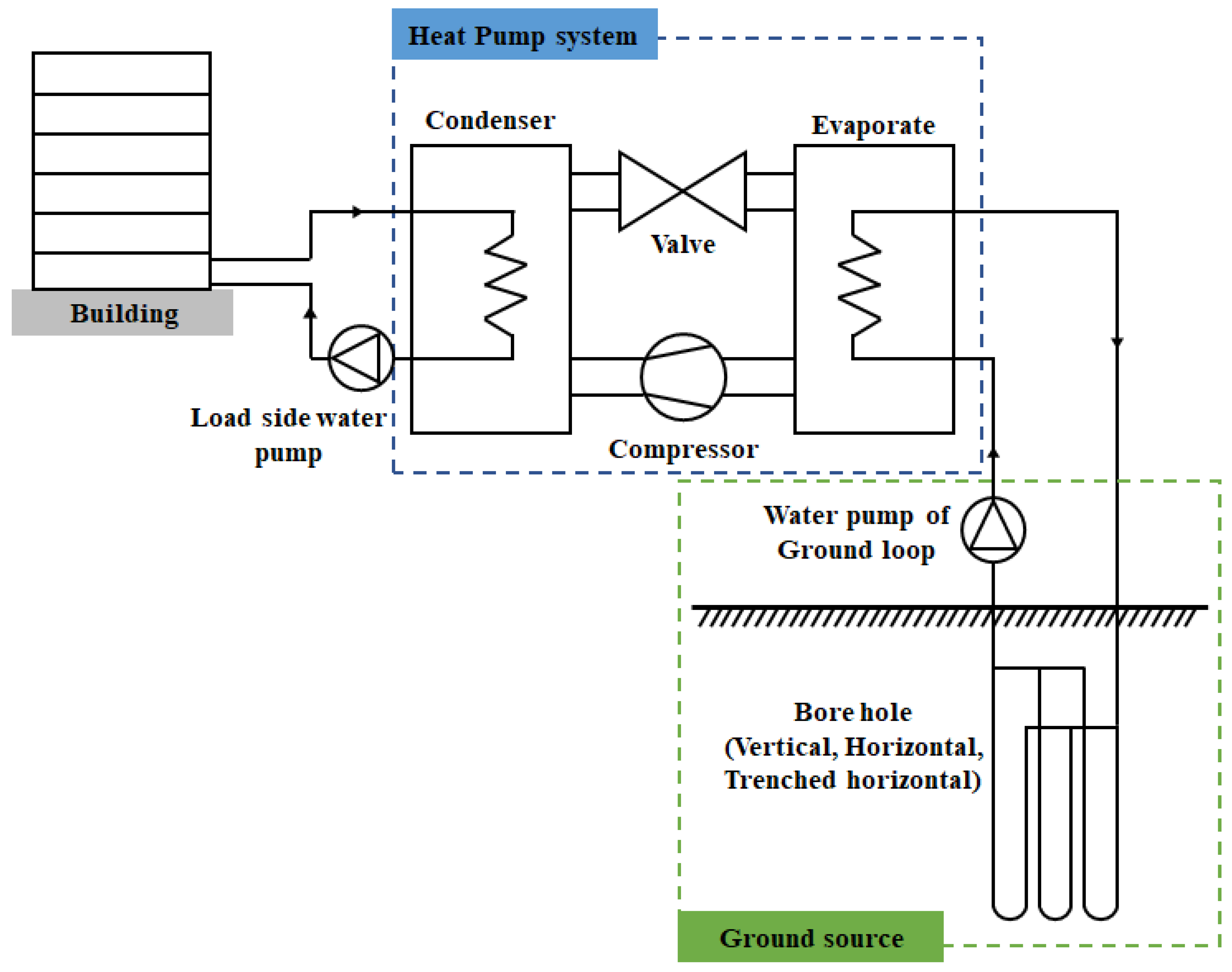
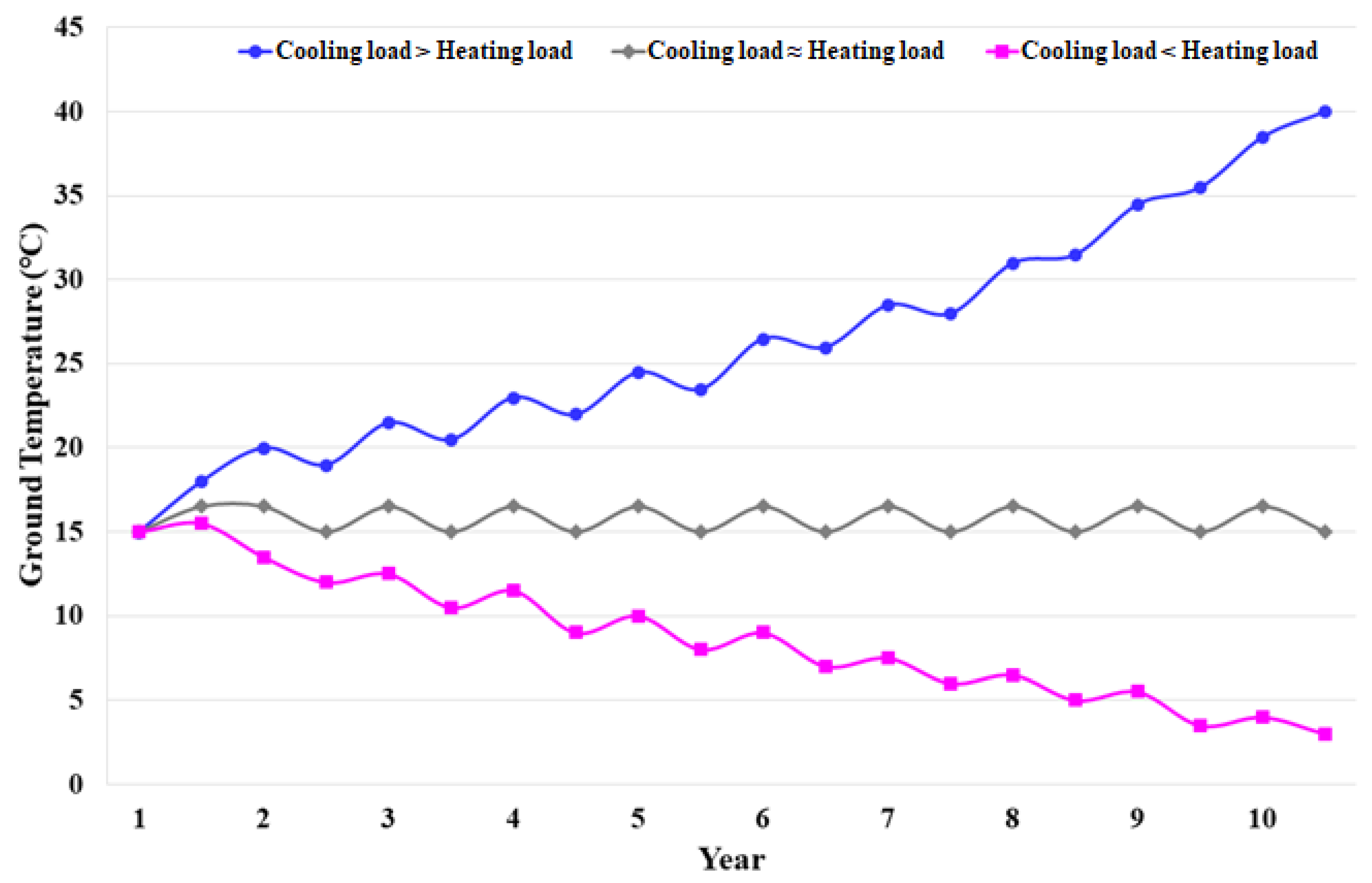

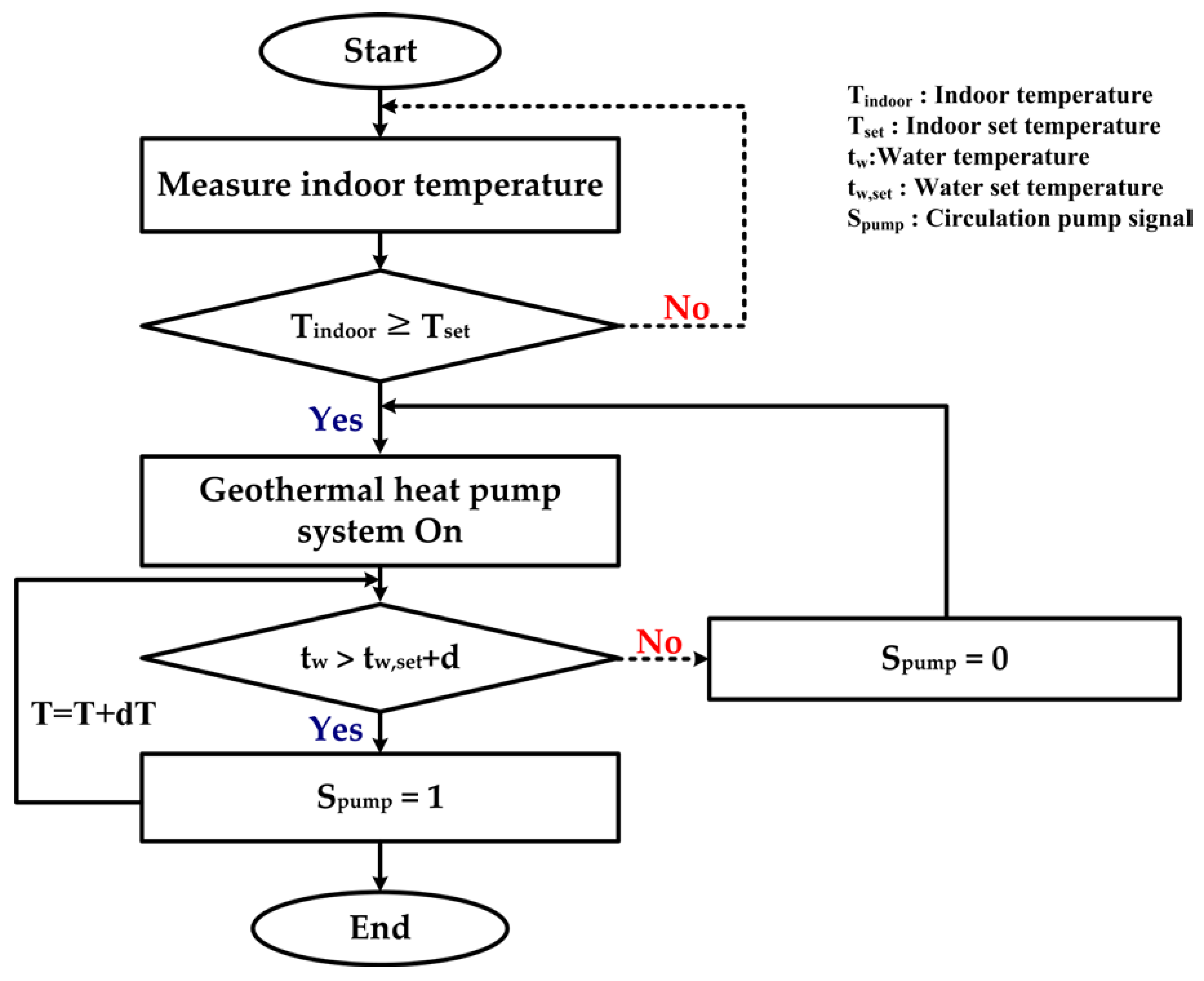
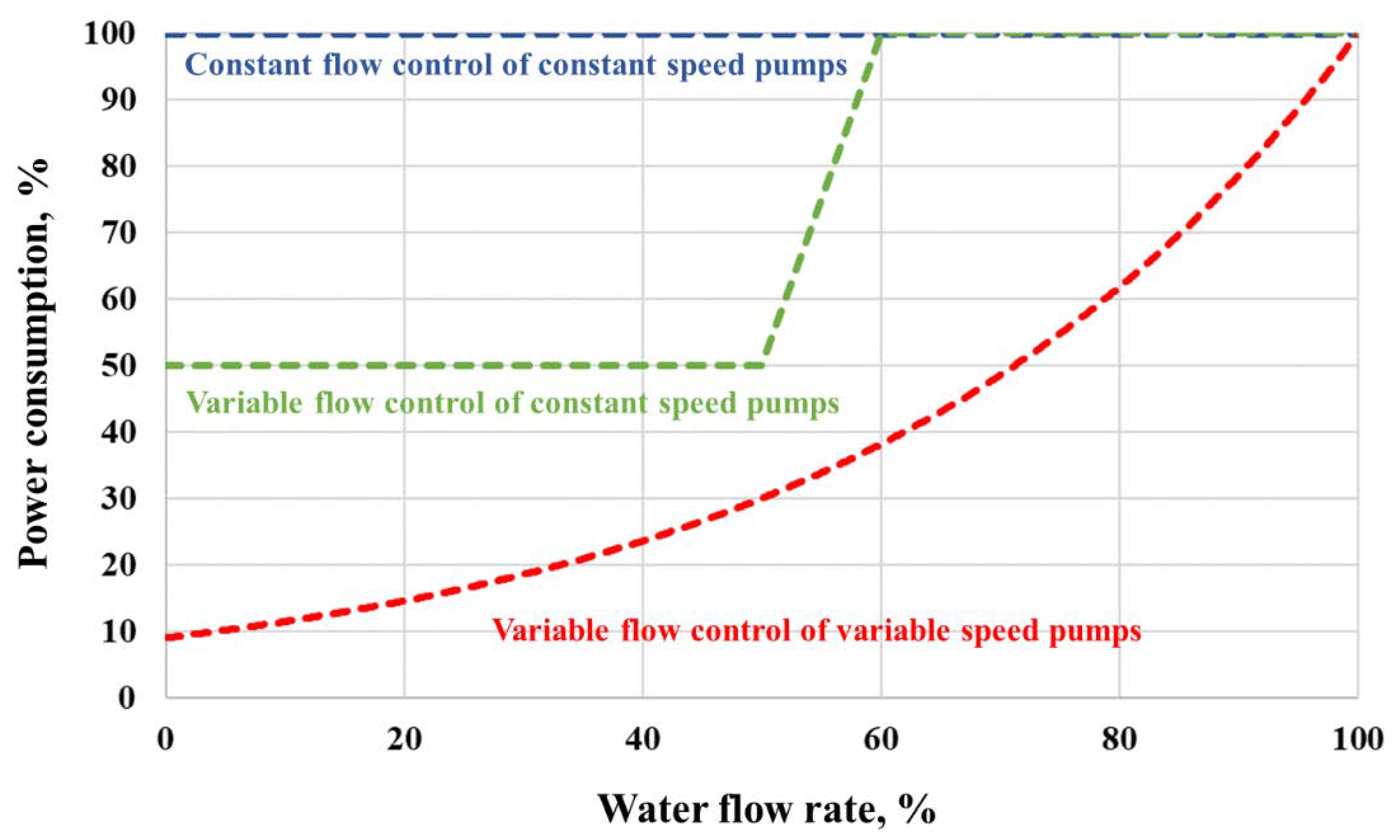
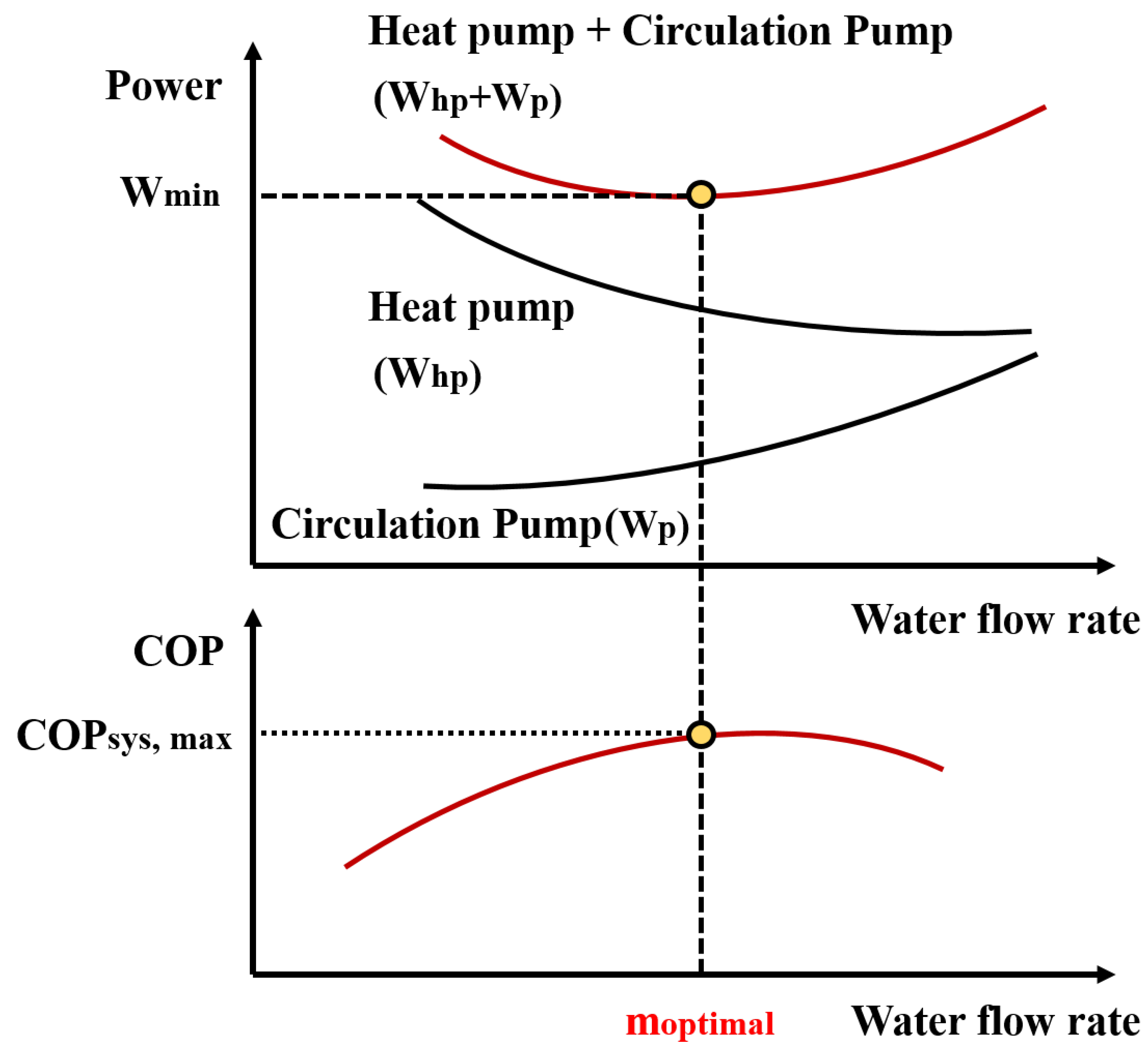
| Category | Contents | Author | |
|---|---|---|---|
| Design of hybrid geothermal heat pump system |
| Albert [37] | |
| Hackel et al. [38] | ||
| Performance analysis of hybrid GHP system | Geothermal + cooling tower geothermal + boiler |
| Hackel et al. [39] |
| Qing et al. [41] | ||
| Xu [42] | ||
| Geothermal + photovoltaic/thermal |
| Wang [40] | |
| Contents | Necessity | Author |
|---|---|---|
|
| Zhenjun Ma et al. [49] |
|
| L. Lu et al. [50] |
|
| Puttige et al. [51] |
|
| Miglani et al. [53] |
|
| Zhao et al. [54] |
Disclaimer/Publisher’s Note: The statements, opinions and data contained in all publications are solely those of the individual author(s) and contributor(s) and not of MDPI and/or the editor(s). MDPI and/or the editor(s) disclaim responsibility for any injury to people or property resulting from any ideas, methods, instructions or products referred to in the content. |
© 2023 by the authors. Licensee MDPI, Basel, Switzerland. This article is an open access article distributed under the terms and conditions of the Creative Commons Attribution (CC BY) license (https://creativecommons.org/licenses/by/4.0/).
Share and Cite
Shin, J.-H.; Kim, H.-J.; Lee, H.-G.; Cho, Y.-H. Variable Water Flow Control of Hybrid Geothermal Heat Pump System. Energies 2023, 16, 6113. https://doi.org/10.3390/en16176113
Shin J-H, Kim H-J, Lee H-G, Cho Y-H. Variable Water Flow Control of Hybrid Geothermal Heat Pump System. Energies. 2023; 16(17):6113. https://doi.org/10.3390/en16176113
Chicago/Turabian StyleShin, Ji-Hyun, Hyo-Jun Kim, Han-Gyeol Lee, and Young-Hum Cho. 2023. "Variable Water Flow Control of Hybrid Geothermal Heat Pump System" Energies 16, no. 17: 6113. https://doi.org/10.3390/en16176113






